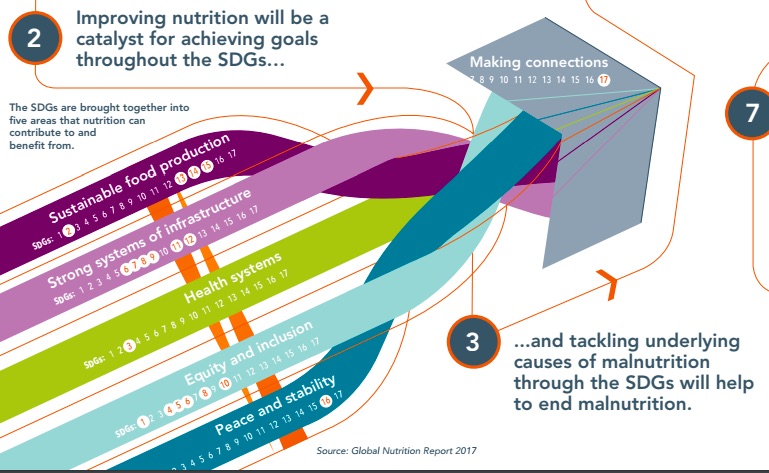Nourishing the Sustainable Development Goals: Global Nutrition Report 2017
In this fourth Global Nutrition Report (GNR), significant burdens of three key forms of malnutrition (child stunting, anaemia in women of reproductive age and overweight in adult women) were found in 140 out of 193 countries. The vast majority (88 per cent) of these countries face a serious burden of two or three of these forms of malnutrition, highlighting the damaging impact on broader global development efforts.
The GNR 2017 has a strong focus on galvanising efforts needed to achieve the Sustainable Development Goals (the SDGs, adopted by 193 countries in 2015), which offer a critical window of opportunity to reverse or stop current trends in malnutrition. It identifies five core areas of development that run through the SDGs to which nutrition can contribute and in turn benefit from (see Figure 1).
Figure 1: Making links between nutrition and the SDGs

Investment in these core areas can have a powerful multiplier effect across the SDGs, according to the GNR. In fact, the report claims that it will be a challenge to achieve any SDGs without reducing malnutrition. There is also an opportunity to achieve global nutrition targets while catalysing other development goals through “double-duty” actions by tackling more than one form of malnutrition at once. These include interventions such as promoting and protecting breastfeeding in the workplace; city planning for safe, nutritious and healthy diets; and universal healthcare provision with undernutrition and diet-related non-communicable disease (NCD) prevention. Further potential “triple-duty actions” which tackle malnutrition and other development challenges are also cited, such as school meal programmes that help improve nutrition as well as supporting livelihoods (for farmers that sell their produce to schools) and education. The GNR calls for integrated action and for everyone working to improve nutrition to identify at least one triple-duty action that tackles both undernutrition and NCDs or obesity and other development goals.
Financing for nutrition is another major topic covered in the report, as are data gaps that are hindering accountability and progress. New analysis for 2017 shows domestic spending on undernutrition varies widely from country to country, with some spending over 10 per cent of their budget on nutrition and others far less.
Donor funding for nutrition rose by just two per cent in 2015 to US$867 million, representing a slight fall in the overall percentage of global aid. The report calls for a tripling of global investments in nutrition to $70bn over the next ten years to tackle childhood stunting, wasting and anaemia and to increase breastfeeding rates. Crucially, spending on prevention and treatment of obesity and NCDs represented just 0.01 per cent of overseas development aid in 2015, a “disturbingly low” level given the enormous global burden of these diseases.
More regular and detailed data, disaggregated by wealth quintiles, gender, geography, age and disability, are needed. National averages are not detailed enough to identify marginalised, vulnerable populations. Two notable data gaps are identified around adolescents (to better understand and tackle nutrition at this critical life stage) and dietary intake.
The GNR’s online Nutrition Country Profiles (for all 193 countries) have been refreshed in 2017 with new data where available. The two-page documents provide a snapshot of over 80 indicators of nutrition status and determinants, food availability, intervention coverage and policies that support good nutrition for each country as well as for six regions and 22 sub-regions. The GNR describes itself as an “intervention” rather than a report and these profiles enable nutrition advocates to mobilise for greater action for nutrition and identify ways to integrate nutrition in related sectors.
For more information, visit this link.
For GNR 2017 Nutrition Country Profiles visit this link.

